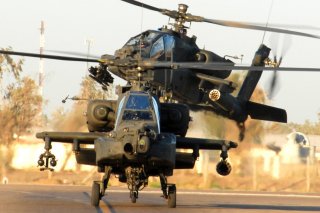The Army May Finally Get Its Stealth Helicopter
Decades in the making.
Here's What You Need to Remember: While rotor blades are, quite naturally, likely to generate some kind of radar signal to enemy systems, depending upon range and the fidelity of a given air defense platform. However, the counter-rotating blades also brings a “sound” advantage by virtue of enabling quieter, stealthier flight trajectories generating a much smaller acoustic signature.
The Army’s Future Long Range Assault Aircraft is slated to enter war by 2030, bringing what service developers say is more than twice the range and speed of existing utility and attack helicopters.
There are several vendors now competing as part of an intense Army competition to ultimately choose and deploy a new fleet of aircraft with a much greater combat radius, fuel efficiency, speed, weapons, sensors and computer systems.
Lockheed Sikorsky-Boeing’s SB Defiant has taken flight more recently than Textron-Bell’s 280 Valor, however both appear to be showing early promise. Sikorsky’s SB Defiant, which recently took a demo flight at a Sikorsky range in West Palm Beach Florida before the Army’s Chief of Staff, has reportedly hit speeds of 250 knots, more than twice that of a current Black Hawk.
The SB Defiant uses an interesting, counter-rotating dual blade technology known as a compound configuration. The counter-rotating blade is based upon innovative engineering methods that combines airplane-like speeds with the hovering and maneuvering capabilities unique to helicopters. The counter-rotating blades are engineered to reduce high-speed vibrations, steady the aircraft and best optimize massive amounts of thrust coming from a pusher prop mechanism in the rear of the aircraft.
“These advancements will prove critical for Army operations in a theater like the Indo-Pacific where the dominant geographical feature is water and yet land forces remain the predominant military force in the majority of nations in the region,” Army Chief of Staff Gen. James McConville said following the flight demo, according to an Army report. “We are flying before buying.”
The Army plans to publish new requirements for the helicopter by 2021 based upon data gathered and lessons learned through ongoing experiments, weapons development and test flights, the report added.
The Sikorsky-Boeing tech demonstrator SB-1 Defiant first took flight in March 2019 and leverages Sikorsky’s X2 technology with a rigid compound rotor and pusher prop.
It is not at all unusual for weapons system requirements to be refined throughout the developmental process of a new platform, given that new things are learned on an ongoing basis.
Interestingly, the rounded, oval-shaped defiant does look a bit stealthy and appears to operate with an internal weapons bay to limit detectable external shapes or contours likely to generate radar signature returns.
While rotor blades are, quite naturally, likely to generate some kind of radar signal to enemy systems, depending upon range and the fidelity of a given air defense platform. However, the counter-rotating blades also brings a “sound” advantage by virtue of enabling quieter, stealthier flight trajectories generating a much smaller acoustic signature. Also, some of the symmetry of the counter rotating blades, closely mirroring each other in shape and size, will decrease turbulence and therefore improve the airflow and stability of flight.
The body shape of the aircraft does appear to blend somewhat gradually up to the rotor blades, as if to decrease sharp angles and engineer a gradual incline or slope from the front end of the aircraft up through the body to the rotor blades. Another huge measure of potential stealth for the aircraft likely resides in its ability to manage a heat signature as well, something about which there may be little information available.
Kris Osborn is Defense Editor for the National Interest. Osborn previously served at the Pentagon as a Highly Qualified Expert with the Office of the Assistant Secretary of the Army—Acquisition, Logistics & Technology. Osborn has also worked as an anchor and on-air military specialist at national TV networks. He has appeared as a guest military expert on Fox News, MSNBC, The Military Channel, and The History Channel. He also has a Masters Degree in Comparative Literature from Columbia University. This article first appeared last year.
Image: Flickr.


